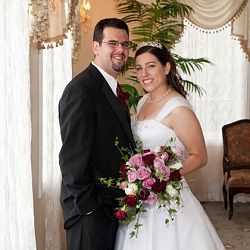Catholic weddings require planning

SALT LAKE CITY -Marriage practices are very diverse across cultures, may take many forms, and are often formalized by a wedding. The Roman Catholic tradition of the 12th and 13th centuries defined marriage as a sacrament ordained by God signifying the mystical marriage of Christ to his Church, a tradition that has carried to the present day.
"The matrimonial covenant, by which a man and a woman establish between themselves a partnership of the whole of life, is by its nature ordered toward the good of the spouses and the procreation and education of offspring; this covenant between baptized persons has been raised by Christ the Lord to the dignity of a sacrament," states the Catechism of the Catholic Church.
The celebration of marriage between two Catholics normally takes place during the public liturgical celebration of the Holy Mass, because of its sacramental connection with the unity of the Paschal mystery of Christ (Communion). Sacramental marriage confers a perpetual and exclusive bond between the spouses. By its nature, the institution of marriage and conjugal love is ordered to the procreation and upbringing of offspring. Marriage creates rights and duties in the Church between the spouses and toward their children.
A couple should approach their pastor six months to a year before they plan to have the ceremony and express their desire to get married, said Timothy Johnston, director of liturgy of the Catholic Diocese of Salt Lake City. "Once that happens, technically there are supposed to be marriage courses, which varies from parish to parish. There's not a set program that people have to do."
One component of the process of marriage is the focus test, which will identify some areas that couples might need to discuss further between themselves. "It also helps couples in some areas; it's a tool for the couple to assess where they are," said Father Langes Silva, judicial vicar of the Tribunal of the Diocese of Salt Lake City.
"It's really an opportunity that opens up for further conversation as the couple prepares for the marriage," said Johnston.
Couples also need to contact their local pastor and complete a document called the prenuptial investigation.
"The prenuptial investigation is a series of questions in order to determine that they are free and willing to enter marriage," Fr. Silva said. "This is followed by another document called the affidavit of freedom."
According to current Catholic legislation governing marriage, the essential properties of marriage are unity and indissolubility. Divorce is not recognized, but annulments predicated upon previously existing impediments may be granted.
"If the couple have previously married, they have to obtain the decree of annulment from the church in which they were married; they need to attach the copies in order to verify that indeed they are free to enter the marriage according to the laws of the Catholic Church," said Fr. Silva.
If one spouse is not Catholic, the priest who marries them must ask for a dispensation of mixed religion or a dispensation of disparital worship.
"When one of the parties is not baptized at all or has been baptized in a church that doesn't have a valid baptism recognition by the Catholic Church, the priest requests a dispensation of disparity of worship," said Fr. Silva, adding that "the Catholic party makes a promise that he or she is going to maintain the faith and also educate and baptize the children according to the teachings of the Catholic Church, and the non-Catholic party has to agree."
It is desirable that everything in the marriage process is documented but in the case that all the documents can't be provided, the priest can ask for affidavits of freedom, that state each of the spouses is free to enter marriage. "These declarations must be signed by a witness, such as a parent or other relative," Fr. Silva said.
The couple is required to attend marriage preparation and engagement encounter sessions. Usually for those, the couples receive a certification to present to their priest to note in the prenuptial investigation.
"It is required that the people, when they approach the priest, provide proof of residence or quasi-residence that is according to the canonical law," said Fr. Silva. This requires that the people have been in that parish for at least six months; when the people do not have six months in residence they must state they have the intention to remain in the parish.
12 steps to planning a Catholic wedding
1. Start the preparation within a year of advance.
2. Get copies of the certificates of baptism and confirmation by calling or writing to the churches that issued them.
3. Get together with your priest and explain your intentions.
4. Select a place to celebrate the wedding.
5. Enroll in an engagement encounter program.
6. Talk with your partner about the children you may have.
7. Order your invitations four to six months in advance.
8. Make premarital appointments with your priest. Bring all your documentation and information about your parish.
9. Ask your priest all the questions you may have before the wedding.
10. Select your readings and the appropriate music for the wedding ceremony.
11. Reserve the church for the event.
12. Send invitations at least six weeks prior your wedding.
© Copyright 2025 The Diocese of Salt Lake City. All rights reserved.

Stay Connected With Us